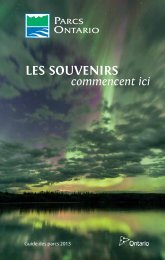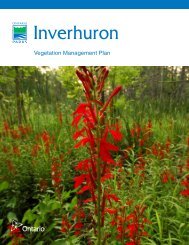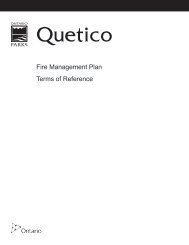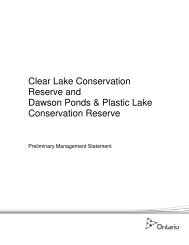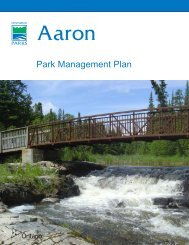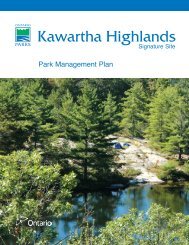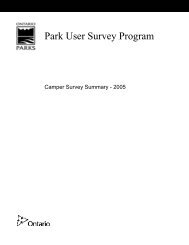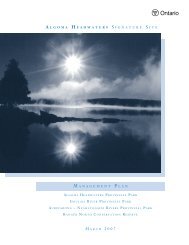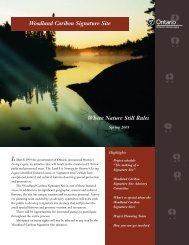Vegetation Plan - Ontario Parks
Vegetation Plan - Ontario Parks
Vegetation Plan - Ontario Parks
You also want an ePaper? Increase the reach of your titles
YUMPU automatically turns print PDFs into web optimized ePapers that Google loves.
APPENDIX 3: NHIC Conservation Ranks<br />
Global (G) and Provincial (S) conservation ranks are determined by the number of known and extant sites of a<br />
species and the degree to which they are considered to be threatened with destruction. Other criteria include<br />
number of known protected populations, population size and the ability of the species to persist at the site (NHIC<br />
2005).<br />
Global Ranks<br />
GRank Definition<br />
G1<br />
Extremely rare; usually 5 or fewer occurrences in the overall range or very few remaining<br />
individuals; or because of some factor(s) making it especially vulnerable to extinction.<br />
G2<br />
Very rare; usually between 5 and 20 occurrences in the overall range or with many individuals<br />
in fewer occurrences; or because of some factor(s) making it vulnerable to extinction.<br />
G3<br />
Rare to uncommon; usually between 20 and 100 occurrences; may have fewer occurrences,<br />
but with a large number of individuals in some populations; may be susceptible to large-scale<br />
disturbances.<br />
G4<br />
Common; usually more than 100 occurrences; usually not susceptible to immediate threats.<br />
G5<br />
Very common; demonstrably secure under present conditions.<br />
GH<br />
Historic; no records in the past 20 years.<br />
GU<br />
Status uncertain, often because of low search effort or cryptic nature of the species; more data<br />
needed.<br />
GX<br />
Globally extinct; no recent records despite specific searches.<br />
? Denotes inexact numeric rank (i.e., G4?).<br />
G<br />
A "G" (or "T") followed by a blank space means that the NHIC has not yet obtained the Global<br />
Rank from The Nature Conservancy.<br />
G? Unranked, or, if following a ranking, rank tentatively assigned (e.g., G3?).<br />
Q<br />
Denotes that the taxonomic status of the species, subspecies, or variety is questionable.<br />
T<br />
Denotes that the rank applies to a subspecies or variety.<br />
Provincial Ranks<br />
Pranks Definition<br />
S1<br />
Extremely rare in <strong>Ontario</strong>; usually 5 or fewer occurrences in the province or very few remaining<br />
individuals; often especially vulnerable to extirpation.<br />
S2<br />
Very rare in <strong>Ontario</strong>; usually between 5 and 20 occurrences in the province or with many<br />
individuals in fewer occurrences; often susceptible to extirpation.<br />
S3<br />
Rare to uncommon in <strong>Ontario</strong>; usually between 20 and 100 occurrences in the province; may<br />
have fewer occurrences, but with a large number of individuals in some populations; may be<br />
susceptible to large-scale disturbances. Most species with an S3 rank are assigned to the watch<br />
list, unless they have a relatively high global rank.<br />
S4<br />
Common and apparently secure in <strong>Ontario</strong>; usually with more than 100 occurrences in the<br />
province.<br />
S5<br />
Very common and demonstrably secure in <strong>Ontario</strong>.<br />
SH<br />
Historically known from <strong>Ontario</strong>, but not verified recently (typically not recorded in the province<br />
in the last 20 years); however, suitable habitat is thought to be still present in the province and<br />
there is reasonable expectation that the species may be rediscovered.<br />
C<br />
Captive/Cultivated; existing in the province only in a cultivated state; introduced population not<br />
yet fully established and self-sustaining.<br />
S? Not ranked yet; or if following a ranking, rank uncertain (e.g., S3?). S? species have not had a<br />
rank assigned.<br />
SA<br />
Accidental; of accidental or casual occurrence in the province; far outside its normal range;<br />
some species may occasionally breed in the province.<br />
SAB<br />
Breeding accidental.<br />
SAN<br />
Non-breeding accidental.<br />
SE<br />
Exotic; not believed to be a native component of <strong>Ontario</strong>'s flora.<br />
SR<br />
Reported for <strong>Ontario</strong>, but without persuasive documentation which would provide a basis for<br />
either accepting or rejecting the report.<br />
32



